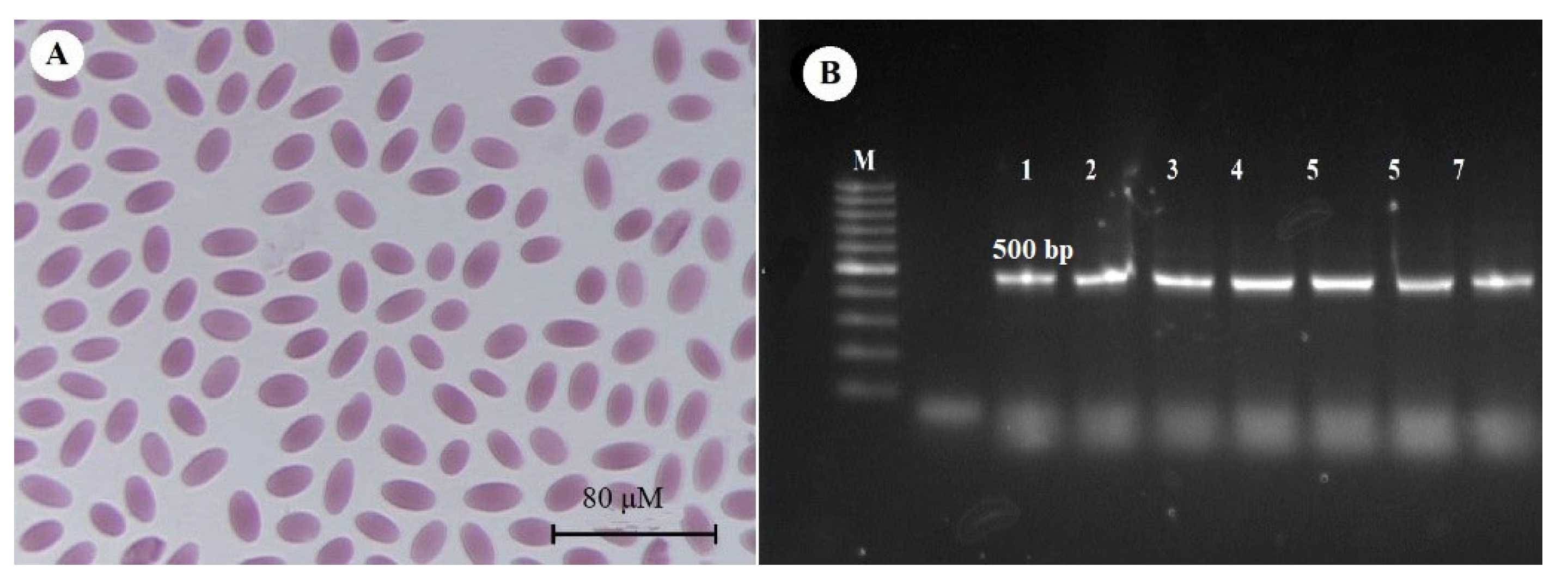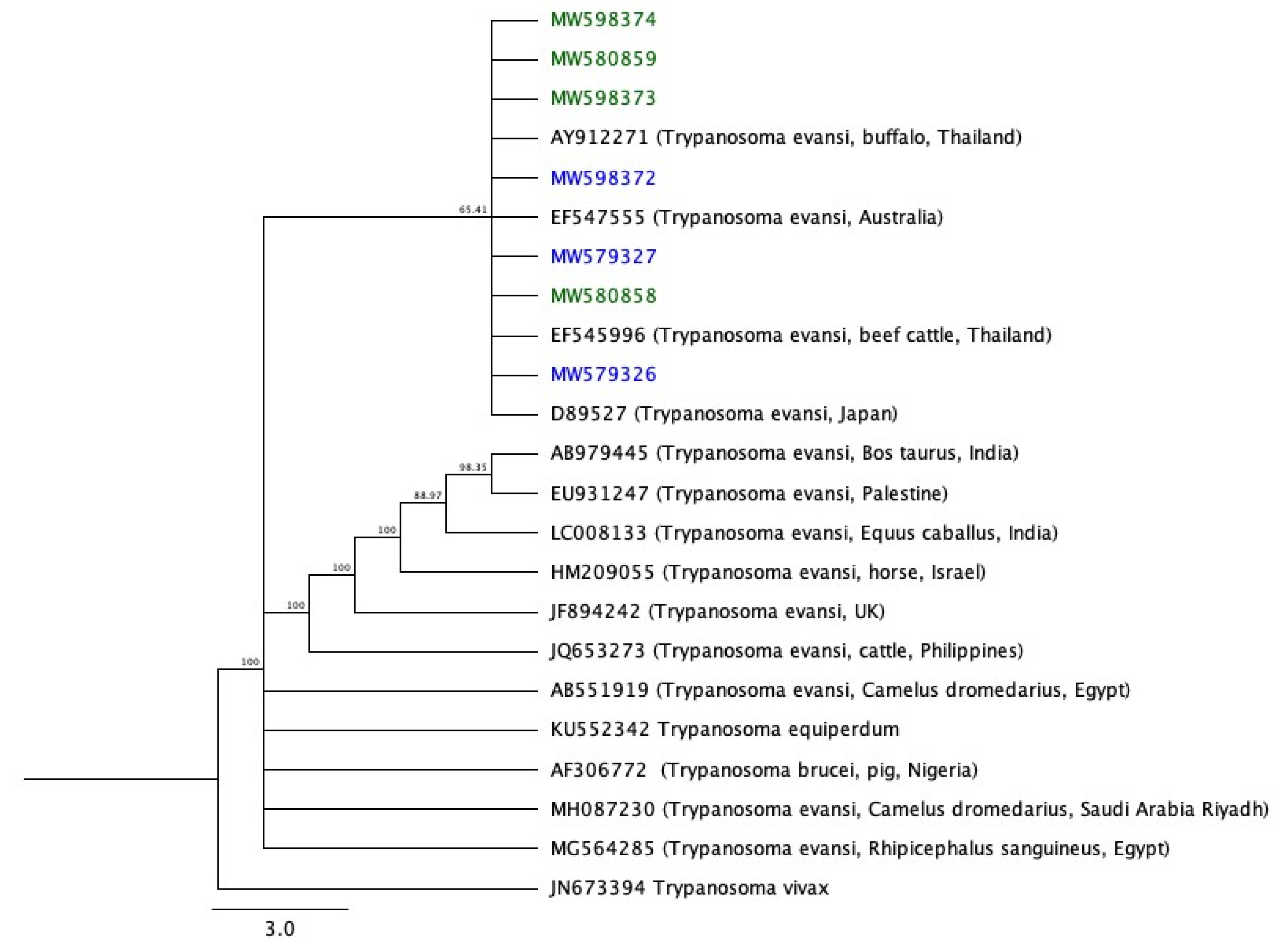Molecular Identification of Trypanosoma evansi Isolated from Arabian Camels (Camelus dromedarius) in Riyadh and Al-Qassim, Saudi Arabia
Simple Summary
Abstract
1. Introduction
2. Materials and Methods
2.1. Ethical Statement
2.2. Study Area
2.3. Collection of Camel Blood Samples
2.4. DNA Extraction and Polymerase Chain Reaction (PCR)
2.5. Nucleotide Sequences of the ITS-1 Gene and Phylogenetic Tree Analysis
2.6. ID of Query Sequence
2.7. Statistical Analysis
3. Results
3.1. Blood Smear Examination and PCR Amplification of T. evansi
3.2. Nucleotide Sequence Analysis of the ITS-1 Gene
4. Discussion
5. Conclusions
Author Contributions
Funding
Institutional Review Board Statement
Data Availability Statement
Acknowledgments
Conflicts of Interest
References
- Luckins, A.G. Trypanosoma evansi in Asia. Parasitol Today 1988, 4, 137–142. [Google Scholar] [CrossRef]
- Luckins, A.G.; Dwinger, R.H. Non-tsetse-transmitted animal trypanosomiasis. Trypanosomiases 2004, 269–281. [Google Scholar] [CrossRef]
- Duquesne, M.; Holzmuller, P.; Lai, D.H.; Dargantes, A.; Lun, Z.R.; Jittaplapong, S. Trypanosoma evansi and Surra: A review and perspectives on origin, history, distribution, taxonomy, morphology, hosts, and pathogenic effects. Biomed. Res. Int. 2013. [Google Scholar] [CrossRef]
- General Authority for Statistics, 2015: Detailed results of the Agriculture Census; Kingdom of Saudi Arabia: Saudi Arabia, 2015; p. 421.
- Kasim, A.A. Detection of Trypanosoma evansi in the Arabian camel. J. Coll. Sci. 1984. [Google Scholar]
- Hussein, H.S.; Al-Asgah, N.A.; Al-Khalifa, M.S.; Diab, F.M. The blood parasites of indigenous livestock in Saudi Arabia. Arab Gulf. J. Sci. Res. 1991, 9, 143–160. [Google Scholar]
- Omer, O.H.; Magzoub, M.; Haroun, E.M.; Mahmoud, O.M.; Hamid, Y.A. Diagnosis of Trypanosoma evansi in Saudi Arabian Camels (Camelus dromedarius) by the passive haemagglutination test and Ag-ELISA. J. Vet. Med. B 1998, 45, 627–633. [Google Scholar] [CrossRef]
- Al-Khalifa, M.S.; Hussein, H.S.; Diab, F.M.; Khalil, G.M. Blood parasites of livestock in certain regions in Saudi Arabia. Saudi J. Biol. Sci. 2009, 16, 63–67. [Google Scholar] [CrossRef] [PubMed]
- Al-Afaleq, A.I.; Elamin, E.A.; Fatani, A.; Homeida, A.G. Epidemiological aspects of camel trypanosomosis in Saudi Arabia. J. Camel Pract. Res. 2015, 22, 231–234. [Google Scholar] [CrossRef]
- Elwathig, M.; Faye, B.; Thevenon, S.; Ravel, S.; Bossard, G. Epidemiological surveys of camel trypanosomosis in Al-Jouf, Saudi Arabia based on PCR and ELISA. Emir. J. Food Agric. 2016, 212–216. [Google Scholar] [CrossRef]
- Alanazi, A.D.; Puschendorf, R.; Alyousif, M.S.; Al-khalifa, M.S.; Alharbi, S.A.; Al Sheri, Z.S.; Said, A.E.; Alanazi, I.O.; Al-Mohammed, H.I. Molecular epidemiological studies on Trypanosoma evansi type a and type b in camels (Camelus dromedaries) from five different regions of Saudi Arabia using the ITS-1 rDNA and rotat 1.2 VSG gene. J. Egypt Soc. Parasitol. 2018, 48, 241–250. [Google Scholar]
- Clausen, P.H.; Wiemann, A.; Patzelt, R.; Kakaire, D.; Poetzsch, C.; Peregrine, A.; Mehlitz, D. Use of a PCR assay for the specific and sensitive detection of Trypanosoma spp. in naturally infected dairy cattle in peri-urban Kampala, Uganda. Ann. N. Y. Acad. Sci. 1998, 849, 21–31. [Google Scholar] [CrossRef]
- Urakawa, T.; Verloo, D.; Moens, L.; Büscher, P.; Majiwa, P.A. Trypanosoma evansi: Cloning and expression in Spodoptera fugiperda insect cells of the diagnostic antigen RoTat1.2. Exp. Parasitol. 2001, 99, 181–189. [Google Scholar] [CrossRef]
- Verloo, D.; Magnus, E.; Büscher, P. General expression of RoTat 1.2 variable antigen type in Trypanosoma evansi isolates from a different origin. Vet. Parasitol. 2001, 97, 185–191. [Google Scholar] [CrossRef]
- Cox, A.; Tilley, A.; McOdimba, F.; Fyfe, J.; Eisler, M.; Hide, G.; Welburn, S. A PCR-based assay for detection and differentiation of African trypanosome species in blood. Exp. Parasitol. 2005, 111, 24–29. [Google Scholar] [CrossRef]
- Njiru, Z.K.; Constantine, C.C.; Guya, S.; Crowther, J.; Kiragu, J.M.; Thompson, R.C.; Dávila, A.M. The use of ITS-1 rDNA PCR in detecting pathogenic African trypanosomes. Parasitol. Res. 2005, 95, 186–192. [Google Scholar] [CrossRef]
- Sengupta, P.P.; Balumahendiran, M.; Suryanarayana, V.V.; Raghavendra, A.G.; Shome, B.R.; Gajendragad, M.R.; Prabhudas, K. PCR-based diagnosis of surra-targeting VSG gene: Experimental studies in small laboratory rodents and buffalo. Vet. Parasitol. 2010, 171, 22–31. [Google Scholar] [CrossRef] [PubMed]
- Salim, B.; Bakheit, M.A.; Kamau, J.; Nakamura, I.; Sugimoto, C. Molecular epidemiology of camel trypanosomiasis based on ITS-1 rDNA and RoTat 1.2 VSG gene in Sudan. Parasit. Vectors 2011, 4, 1–5. [Google Scholar] [CrossRef] [PubMed]
- Birhanu, H.; Gebrehiwot, T.; Goddeeris, B.M.; Büscher, P.; Van Reet, N. New Trypanosoma evansi type B isolates from Ethiopia dromedary camels. PLoS Negl. Trop. Dis. 2016, 10, e0004556. [Google Scholar] [CrossRef]
- Sumbria, D.; Singla, L.D.; Sharma, A.; Bal, M.S.; Kumar, S. Multiplex PCR for detection of Trypanosoma evansi and Theileria equi in equids of Punjab, India. Vet. Parasitol. 2015, 211, 293–299. [Google Scholar] [CrossRef]
- Tehseen, S.; Jahan, N.; Desquesnes, M.; Shahzad, M.I.; Qamar, M.F. Field investigation of Trypanosoma evansi and comparative analysis of diagnostic tests in horses from Bahawalpur, Pakistan. Turkish J. Vet. Anim. Sci. 2017, 41, 288–293. [Google Scholar] [CrossRef]
- Khuchareontaworn, S.; Singhaphan, P.; Viseshakul, N.; Chansiri, K. Genetic diversity of Trypanosoma evansi in buffalo based on internal transcribed spacer (ITS) regions. J. Vet. Med. Sci. 2007, 69, 487–493. [Google Scholar] [CrossRef] [PubMed]
- Amer, S.; Ryu, O.; Tada, C.; Fukuda, Y.; Inoue, N.; Nakai, Y. Molecular identification and phylogenetic analysis of Trypanosoma evansi from dromedary camels (Camelus dromedarius) in Egypt, a pilot study. Acta Trop. 2011, 117, 39–46. [Google Scholar] [CrossRef] [PubMed]
- Grisard, E.C.; Campbell, D.A.; Romanha, A.J. Mini-exon gene sequence polymorphism among Trypanosoma rangeli strains isolated from distinct geographical regions. Parasitology 1999, 118, 375–382. [Google Scholar] [CrossRef]
- Agbo, E.E.; Majiwa, P.A.; Claassen, H.J.; te Pas, M.F. Molecular variation of Trypanosoma brucei subspecies as revealed by AFLP fingerprinting. Parasitology 2002, 124, 349–358. [Google Scholar] [CrossRef]
- Omanwar, S.; Singh, R.K.; Butchaiah, G.; Rao, J.R. DNA polymorphism in Trypanosoma evansi isolates defined by randomly amplified polymorphic DNA-PCR. Vet. Rec. 2001, 148, 244–246. [Google Scholar] [CrossRef]
- Njiru, Z.K.; Constantine, C.C.; Gitonga, P.K.; Thompson, R.C.; Reid, S.A. Genetic variability of Trypanosoma evansi isolates detected by inter-simple sequence repeat anchored-PCR and microsatellite. Vet. Parasitol. 2007, 147, 51–60. [Google Scholar] [CrossRef]
- Geneious Prime. Available online: http://www.geneious.com/ (accessed on 7 April 2020).
- Altschul, S.F.; Gish, W.; Miller, W.; Myers, E.W.; Lipman, D.J. Basic local alignment search tool. J. Mol. Biol. 1990, 215, 403–410. [Google Scholar] [CrossRef]
- Sievers, F.; Wilm, A.; Dineen, D.; Gibson, T.J.; Karplus, K.; Li, W.; Lopez, R.; McWilliam, H.; Remmert, M.; Söding, J.; et al. Fast, scalable generation of high-quality protein multiple sequence alignments using Clustal Omega. Mol. Syst. Biol. 2011, 7, 539. [Google Scholar] [CrossRef]
- Saitou, N.; Nei, M. The neighbor-joining method: A new method for reconstructing phylogenetic trees. Mol. Biol. Evol. 1987, 4, 406–425. [Google Scholar]
- Li, S.Q.; Yang, W.B.; Lun, Z.R.; Ma, L.J.; Xu, S.M.; Chen, Q.L.; Song, X.W.; Kang, J.; Yang, L.Z. Immunization with recombinant actin from Trypanosoma evansi induces protective immunity against T. evansi, T. equiperdum, and T. brucei infection. Parasitol. Res. 2009, 104, 429–435. [Google Scholar] [CrossRef]
- Sengupta, P.P.; Balumahendiran, M.; Balamurugan, V.; Rudramurthy, G.R.; Prabhudas, K. Expressed truncated N-terminal variable surface glycoprotein (VSG) of Trypanosoma evansi in E. coli exhibits immunoreactivity. Vet. Parasitol. 2012, 187, 1–8. [Google Scholar] [CrossRef]
- Beltrame-Botelho, I.T.; Gaspar-Silva, D.; Steindel, M.; Dávila, A.M.; Grisard, E.C. Internal transcribed spacers (ITS) of Trypanosoma rangeli ribosomal DNA (rDNA): A useful marker for inter-specific differentiation. Infect. Genet. Evol. 2005, 5, 17–28. [Google Scholar] [CrossRef]
- Barghash, S.M.; Darwish, A.M.; Abou-ElNaga, T.R. Molecular characterization and phylogenetic analysis of Trypanosoma evansi from local and imported camels in Egypt. J. Phylogenetics Evol. Biol. 2016, 4, 18. [Google Scholar] [CrossRef]
- Al-Amery, A.M.; Faraj, A.A.; Majeed, S.A. Detection of haemoprotozoa in camels in Al Najaf province, Iraq. Int. J. Adv. Biol. Res. 2017, 7, 238–241. [Google Scholar]
- Abdel-Rady, A. Comparison of card agglutination test and parasitological methods for the diagnosis of camel trypanosomosis in Egypt. In Proceedings of the International Scientific Conference on Camels, Qassim, Saudia Arabian, 9–11 May 2006; pp. 571–576. [Google Scholar]
- Zayed, A.A.; Habeeb, S.M.; Allam, N.A.; Ashry, H.M.; Mohamed, A.H.; Ashour, A.A.; Taha, H.A. A critical comparative study of parasitological and serological differential diagnostic methods of Trypanosoma evansi infections in some farm animals in Egypt. Am. Eurasian J. Agric. Environ. Sci. 2010, 8, 633–642. [Google Scholar]
- El-Haig, M.M.; Youssef, A.I.; El-Gayar, A.K. Molecular and parasitological detection of Trypanosoma evansi in camels in Ismailia, Egypt. Vet. Parasitol. 2013, 198, 214–218. [Google Scholar] [CrossRef] [PubMed]
- Taylor, T.K.; Boyle, D.B.; Bingham, J. Development of a TaqMan PCR assay for the detection of Trypanosoma evansi, the agent of Surra. Vet. Parasitol. 2008, 153, 255–264. [Google Scholar] [CrossRef] [PubMed]
- Areekit, S.; Singhaphan, P.; Kanjanavas, P.; Khuchareontaworn, S.; Sriyapai, T.; Pakpitcharoen, A.; Chansiri, K. Genetic diversity of Trypanosoma evansi in beef cattle based on internal transcribed spacer region. Inf. Genet. Evol. 2008, 8, 484–488. [Google Scholar] [CrossRef] [PubMed]
- Agbo, E.C.; Majiwa, P.A.; Claassen, E.J.; Roos, M.H. The measure of molecular diversity within the Trypanosoma brucei subspecies Trypanosoma brucei and Trypanosoma brucei gambiense as revealed by genotypic characterization. Exp. Parasitol. 2001, 99, 123–131. [Google Scholar] [CrossRef]
- Stevens, J.R.; Noyes, H.A.; Dover, G.A.; Gibson, W.C. The ancient and divergent origins of the human pathogenic trypanosomes, Trypanosoma brucei and T. cruzi. Parasitology 1999, 118, 107–116. [Google Scholar] [CrossRef] [PubMed]
- Ibrahim, H.; Malele, I.; Nyingilili, H.; Sadeq, S.; Brooks, D.; Ali, N. Phylogenetic analysis of Trypanosoma evansi in naturally infected camels from Sudan based on ribosomal DNA sequences citation. Am. J. Microbiol. Biotechnol. 2017, 4, 75–82. [Google Scholar]


| Gene | Primers | Sequences | References |
|---|---|---|---|
| ITS-1 | ITS-1 CF | 5′-CCGGAAGTTCACCGATATTG-3′ | [16] |
| ITS-1 BR | 5′-TGCTGCGTTCTTCAACGAA-3′ |
| Region * | No. | Microscopic Examination | PCR (ITS-1) |
|---|---|---|---|
| Riyadh | 200 | 0:00 (0%) | 79 (39.5%) |
| Al-Qassim | 200 | 0:00 (0%) | 92 (46%) |
| Categories | Riyadh | Al-Qassim | ||||
|---|---|---|---|---|---|---|
| No. of Examined | No. of Infected | % of Infected | No. of Examined | No. of Infected | % of Infected | |
| Young male camels | 22 | 12 | 54.5% | 25 | 15 | 60% |
| Adult male camels | 45 | 17 | 37.80% | 46 | 17 | 37% |
| Young female camels | 52 | 21 | 40.40% | 49 | 20 | 40.80% |
| Adult female camels | 81 | 29 | 35.80% | 80 | 40 | 50% |
| χ2 | The chi-square statistic is 2.62. The p-value is 0.45. The result is not significant at p ≤ 0.05. | The chi-square statistic is 4.53. The p-value is 0.21 The result is not significant at p ≤ 0.05. | ||||
Publisher’s Note: MDPI stays neutral with regard to jurisdictional claims in published maps and institutional affiliations. |
© 2021 by the authors. Licensee MDPI, Basel, Switzerland. This article is an open access article distributed under the terms and conditions of the Creative Commons Attribution (CC BY) license (https://creativecommons.org/licenses/by/4.0/).
Share and Cite
Metwally, D.M.; Al-Turaiki, I.M.; Altwaijry, N.; Alghamdi, S.Q.; Alanazi, A.D. Molecular Identification of Trypanosoma evansi Isolated from Arabian Camels (Camelus dromedarius) in Riyadh and Al-Qassim, Saudi Arabia. Animals 2021, 11, 1149. https://doi.org/10.3390/ani11041149
Metwally DM, Al-Turaiki IM, Altwaijry N, Alghamdi SQ, Alanazi AD. Molecular Identification of Trypanosoma evansi Isolated from Arabian Camels (Camelus dromedarius) in Riyadh and Al-Qassim, Saudi Arabia. Animals. 2021; 11(4):1149. https://doi.org/10.3390/ani11041149
Chicago/Turabian StyleMetwally, Dina M., Isra M. Al-Turaiki, Najwa Altwaijry, Samia Q. Alghamdi, and Abdullah D. Alanazi. 2021. "Molecular Identification of Trypanosoma evansi Isolated from Arabian Camels (Camelus dromedarius) in Riyadh and Al-Qassim, Saudi Arabia" Animals 11, no. 4: 1149. https://doi.org/10.3390/ani11041149
APA StyleMetwally, D. M., Al-Turaiki, I. M., Altwaijry, N., Alghamdi, S. Q., & Alanazi, A. D. (2021). Molecular Identification of Trypanosoma evansi Isolated from Arabian Camels (Camelus dromedarius) in Riyadh and Al-Qassim, Saudi Arabia. Animals, 11(4), 1149. https://doi.org/10.3390/ani11041149







